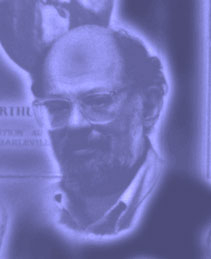
Allen Ginsberg
by Peter Hale
WAKING
IN NEW YORK REVIEWS
Lovely, effecting and affecting
THE NEW YORK TIMES
Strange but oddly compelling work...often wild and marvelously demented chord changes... this is a music of Gotham updated to our times, immortalized by one of its best poetic voices, and put in motion by a composer in tune with the pulse of her city. AMERICAN RECORD GUIDE
Lauten
reveals greater artistry the further you look beneath the surface, successfully
marking the leaps in Ginsberg's own impressionistic narrative with appropriate
changes in metre and key
.GRAMOPHONE UK
The
poetry of Allen Ginsberg has inspired a wide range of composers from Lee
Hyla (whose Howl pits the Kronos Quartet against a recording of Ginsberg
reading his celebrated poem) to Philip Glass (whose Ginsberg settings
include the eclectic Hydrogen Jukebox and Symphony #6 which is a Mahlerian
adaptation of Ginsberg's Plutonian Ode.) In terms of authenticity, however,
all are trumped by Lauten's moving memorial to her creative mentor.
NEW MUSIC BOX
The
New York City Opera
VOX and Friends 2004 presents
Elodie Lauten's Waking in New York
This presentation of a fully orchestrated Waking in New York, Portrait of Allen Ginsberg,performed at Symphony Spaceby the New York City Opera Orchestra and Singers, conducted by Jeffrey Domoto, included most scenes of the second act, sequentially: Personals Ad, Jumping the Gun on the Sun, Manhattan Thirties Flash, The Weight of the World Is Love, and O New York.
What is the story in WAKING IN NEW YORK? It is about experiencing daily life in New York, through the eyes of Ginsberg, the cool post-Beat poet, voice of 1960s radical America. Ginsberg's poems are intensely personal, too relentlessly honest to filter out any detail of daily life. He is in a state of mind that Buddhists call "being ordinary", just living his life moment by moment. From his apartment in the East Village, he is transparent: he tells everything about his state of mind, bodily functions, illnesses, food, his work, political concerns, all in the same breath. He is in a constant dialogue with his muses. And suddenly, he stops to look at the beauty of a tree or the odd shape of a rooftop. He finds inspiration in an exhaust pipe, a non-biodegradable garbage bag. He tells stories about the real people who lived in his building and the odd mix of characters who inhabited the East Village at the time. He shares his own struggle with his aging body. Ginsberg also expresses his love of life in a down-to-earth, occasionally satirical vision of the world, alternating with moments of deep emotion and classic lyricism. In the light of the events of 9/11, there is an uplifting, comforting element in Ginsberg's tolerant and all-inclusive vision of the city with its exciting jaggedness, its energy, which makes it a desirable place to live.
I met Ginsberg
in 1973 when at 22, I first came to New York. I stayed at his apartment
on Avenue C and 10th St, and occasionally accompanied him in his public
readings. Encouraging me to compose, he brought home a Farfisa organ and
that was my first experience with an electronic instrument. He also introduced
me to Buddhism with the chanting of mantras and meditation. Albeit unconventional,
some form of mentoring took place and I have always felt deeply connected
to his life and work. I interpreted his texts from the point of view of
Mahayana - the "great path" of compassion, in the sense of caring for
humanity at large. In his poems, I heard other voices in his head, extensions
of his consciousness, and I created the characters of the muses Freedom
and Compassion to interact with him. Generally,
I stayed very close to Allen's train of thought, alternatively introspective
and expansive, edgy, playful or lyrical, sometimes triggering hints of
different musical styles, but twice removed, never as direct quotes. It
was like making film music with images provided by his consciousness -
until the melody found its way of taking over: I broke free from the obvious
narrative over music approach, every word is sung, even the most unlikely."
Acknowledgement: The presentation of Waking in New York at the New York City Opera was supported in part by the American Music Center.